Effect of Whey Proteins on Malnutrition and Extubating Time of Critically Ill COVID-19 Patients
Abstract
:1. Introduction
2. Materials and Methods
2.1. Study Protocol
2.2. Nutritional Strategy Scheme
- Starting of EN within 24 to 48 h from ICU admission, aiming to cover 50% of caloric needs;
- Ramping up to 80–100% of caloric needs after 48 h;
- Aiming a caloric target of 20–25 kcal/kg/day;
- Using high-protein, 100% whey proteins, casein free, low in carbohydrate (CHO) content, and with a fat/CHO ratio of 50/50 EN formula, rich in Medium-Chain Triglycerides (MCT) and omega-3 fatty acids, with a complete vitamins, minerals, and trace elements profile.
- Calories:11–14 kcal/kg current body weight/day, for BMI of 30–50;22–25 kcal/kg IBW, for BMI > 50;65–70% of the measured calories.
- Protein intake:2 g/kg IBW for BMI 30–50;2.5 g/kg IBW for BMI > 50.
2.3. Indirect Calorimetric Measurements
2.4. Data Collection
2.5. Statistical Analysis
3. Results
4. Discussion
5. Conclusions
Author Contributions
Funding
Institutional Review Board Statement
Informed Consent Statement
Data Availability Statement
Conflicts of Interest
References
- To, K.K.; Sridhar, S.; Chiu, K.H.; Hung, D.L.; Li, X.; Hung, I.F.; Tam, A.R.; Chung, T.W.; Chan, J.F.; Zhang, A.J.; et al. Lessons learned 1 year after SARS-CoV-2 emergence leading to COVID-19 pandemic. Emerg. Microbes Infect. 2021, 10, 507–535. [Google Scholar] [CrossRef] [PubMed]
- Gruppo italiano per la Valutazione degli interventi in Terapia Intensiva, GiViTI. Available online: https://giviti.marionegri.it (accessed on 1 March 2020).
- Merker, M.; Felder, M.; Gueissaz, L.; Bolliger, R.; Tribolet, P.; Kägi-Braun, N.; Gomes, F.; Hoess, C.; Pavlicek, V.; Bilz, S.; et al. Association of Baseline Inflammation with Effectiveness of Nutritional Support among Patients with Disease-Related Malnutrition: A Secondary Analysis of a Randomized Clinical Trial. JAMA Netw. Open 2020, 3, e200663. [Google Scholar] [CrossRef] [PubMed]
- White, J.V.; Guenter, P.; Jensen, G.L.; Malone, A.; Schofield, M. Consensus Statement: Academy of Nutrition and Dietetics and American Society for Parenteral and Enteral Nutrition: Characteristics recommended for the identification and documentation of adult malnutrition (under-nutrition). JPEN J. Parent Ent. Nutr. 2012, 36, 275–283. [Google Scholar] [CrossRef] [PubMed] [Green Version]
- Zheng, Z.Y.; Heyland, D.K. Determination of nutrition risk and status in critically ill patients: What are our considerations? Nutr. Clin. Pract. 2019, 34, 96–111. [Google Scholar]
- Sharma, K.; Mogensen, K.M.; Robinson, M.K. Pathophysiology of critical illness and role of nutrition. Nutr. Clin. Pract. 2019, 34, 12–22. [Google Scholar] [CrossRef] [PubMed] [Green Version]
- Yang, Q.; Liu, W.; Yu, J.; Jiang, J.; Xu, T.; Zhou, Y. Effect of pre-albumin level on mortality in heatstroke patients. Exp. Ther. Med. 2019, 17, 3053–3060. [Google Scholar] [CrossRef] [Green Version]
- Soeters, P.B.; Wolfe, R.R.; Shenkin, A. Hypoalbuminemia: Pathogenesis and clinical significance. JPEN J. Parenter Enteral. Nutr. 2019, 43, 181–193. [Google Scholar] [CrossRef] [Green Version]
- Jensen, G.L.; Bistrian, B.; Roubenoff, R.; Heimburger, D.C. Malnutrition syndromes: A conundrum vs. continuum. JPEN J. Parenter Enteral Nutr. 2009, 33, 710–716. [Google Scholar] [CrossRef]
- Bernstein, L.H. The transthyretin inflammatory state conundrum. Curr. Nutr. Food Sci. 2012, 8, 149–153. [Google Scholar] [CrossRef]
- Loftus, T.J.; Brown, M.P.; Slish, J.H.; Rosenthal, M.D. Serum levels of pre-albumin and albumin for preoperative risk stratification. Nutr. Clin. Pract. 2019, 34, 340–348. [Google Scholar] [CrossRef]
- Evans, D.C.; Corkins, M.R.; Malone, A.; Miller, S.; Mogensen, K.M.; Guenter, P.; Jensen, G.L.; ASPEN Malnutrition Committee. The Use of Visceral Proteins as Nutrition Markers: An ASPEN Position Paper. Nutr. Clin. Pract. 2021, 36, 22–28. [Google Scholar] [CrossRef] [PubMed]
- Seltzer, M.H.; Fletcher, H.S.; Slocum, B.A.; Engler, P.E. Instant nutritional assessment in the intensive care unit. J. Parenter Enteral Nutr. 1981, 5, 70–72. [Google Scholar] [CrossRef] [PubMed]
- JeVenn, A.K.; Galang, M.; Hipskind, P.; Bury, C. Malnutrition screening and assessment. In The ASPEN Adult Nutrition Support Core Curriculum, 3rd ed.; Mueller, C.M., Ed.; ASPEN: Silver Spring, MD, USA, 2017; Volume 10, pp. 185–212. [Google Scholar]
- Rahman, A.; Hasan, R.M.; Agarwala, R.; Martin, C.; Day, A.G.; Heyland, D.K. Identifying critically ill patients who will benefit most from nutritional therapy: Further validation of the “modified NUTRIC” nutritional risk assessment tool. Clin. Nutr. 2016, 35, 158–162. [Google Scholar] [CrossRef] [PubMed]
- Coronavirus Disease 2019 (COVID-19) Treatment Guidelines [Internet]; National Institutes of Health (US): Bethesda, MD, USA, 2021.
- Mitchell, A.; Clemente, R.; Downer, C.; Greer, F.; Allan, K.; Collinson, A.; Taylor, S. Protein Provision in Critically Ill Adults Requiring Enteral Nutrition: Are Guidelines Being Met? Nutr. Clin. Pract. 2019, 34, 123–130. [Google Scholar] [CrossRef] [Green Version]
- McClave, S.A.; DiBaise, J.K.; Mullin, G.E.; Martindale, R.G. ACG Clinical Guideline: Nutrition Therapy in the Adult Hospitalized Patient. Am. J. Gastroenterol. 2016, 111, 315–334. [Google Scholar] [CrossRef]
- Oshima, T.; Delsoglio, M.; Dupertuis, Y.M.; Singer, P.; De Waele, E.; Veraar, C.; Heidegger, C.P.; Wernermann, J.; Wischmeyer, P.E.; Berger, M.M.; et al. The clinical evaluation of the new indirect calorimeter developed by the ICALIC project. Clin. Nutr. 2020, 39, 3105–3111. [Google Scholar] [CrossRef] [PubMed]
- Occhiali, E.; Urli, M.; Pressat-Laffouilhère, T.; Achamrah, N.; Veber, B.; Clavier, T. Dynamic metabolic changes measured by indirect calorimetry during the early phase of septic shock: A prospective observational pilot study. Eur. J. Clin. Nutr. 2021, 1–5. [Google Scholar] [CrossRef]
- Niederer, L.E.; Miller, H.; Haines, K.L.; Molinger, J.; Whittle, J.; MacLeod, D.B.; McClave, S.A.; Wischmeyer, P.E. Prolonged progressive hypermetabolism during COVID-19 hospitalization undetected by common predictive energy equations. Clin. Nutr. ESPEN 2021, 45, 341–350. [Google Scholar] [CrossRef]
- Zinellu, A.; Mangoni, A.A. Serum Pre-albumin Concentrations, COVID-19 Severity, and Mortality: A Systematic Review and Meta-Analysis. Front. Med. 2021, 8, 638529. [Google Scholar] [CrossRef]
- Christman, J.W.; McCain, R.W. A sensible approach to the nutritional support of mechanically ventilated critically ill patients. Intensive Care Med. 1993, 19, 129–136. [Google Scholar] [CrossRef]
- Nichols, D.C.; Flannery, A.H.; Magnuson, B.L.; Cook, A.M. Pre-albumin Is Associated with In-Hospital Mortality in Critically Ill Patients. Nutr. Clin. Pract. 2020, 35, 572–577. [Google Scholar] [CrossRef] [PubMed]
- Mousavi Maleki, M.S.; Rostamian, M.; Madanchi, H. Antimicrobial peptides and other peptide-like therapeutics as promising candidates to combat SARS-CoV-2. Expert Rev. Anti Infect. Ther. 2021, 19, 1205–1217. [Google Scholar] [CrossRef]
- Ali, A.M.; Kunugi, H. Hypoproteinemia predicts disease severity and mortality in COVID-19: A call for action. Diagn. Pathol. 2021, 16, 31. [Google Scholar] [CrossRef] [PubMed]
- Chapple, L.S.; Tatucu-Babet, O.A.; Lambell, K.J.; Fetterplace, K.; Ridley, E.J. Nutrition guidelines for critically ill adults admitted with COVID-19: Is there consensus? Clin. Nutr. ESPEN 2021, 44, 69–77. [Google Scholar] [CrossRef] [PubMed]
- De Waele, E.; Jonckheer, J.; Wischmeyer, P.E. Indirect calorimetry in critical illness: A new standard of care? Curr. Opin. Crit. Care 2021, 27, 334–343. [Google Scholar] [CrossRef]
- Pertzov, B.; Bar-Yoseph, H.; Menndel, Y.; Bendavid, I.; Kagan, I.; Glass, Y.D.; Singer, P. The effect of indirect calorimetry guided isocaloric nutrition on mortality in critically ill patients-a systematic review and meta-analysis. Eur. J. Clin. Nutr. 2021. [Google Scholar] [CrossRef]
- Bernstein, L. Measurement of visceral protein status in assessing protein and energy malnutrition: Standard of care. Pre-albumin in Nutritional Care Consensus Group. Nutrition 1995, 11, 169–171. [Google Scholar]
- Bharadwaj, S.; Ginoya, S.; Tandon, P.; Gohel, T.D.; Guirguis, J.; Vallabh, H.; Jevenn, A.; Hanouneh, I. Malnutrition: Laboratory markers vs. nutritional assessment. Gastroenterol. Rep. 2016, 4, 272–280. [Google Scholar] [CrossRef] [PubMed] [Green Version]
- Davis, C.J.; Sowa, D.; Keim, K.S.; Kinnare, K.; Peterson, S. The use of pre-albumin and C-reactive protein for monitoring nutrition support in adult patients receiving enteral nutrition in an urban medical center. JPEN J. Parenter Enteral Nutr. 2012, 36, 197–204. [Google Scholar] [CrossRef]
- McClave, S.A.; Taylor, B.E.; Martindale, R.G.; Warren, M.M.; Johnson, D.R.; Braunschweig, C.; McCarthy, M.S.; Davanos, E.; Rice, T.W.; Cresci, G.A.; et al. Guidelines for the Provision and Assessment of Nutrition Support Therapy in the Adult Critically Ill Patient: Society of Critical Care Medicine (SCCM) and American Society for Parenteral and Enteral Nutrition (A.S.P.E.N.). JPEN J. Parenter Enteral Nutr. 2016, 40, 159–211. [Google Scholar] [CrossRef] [PubMed]
- Issever, K.; Genc, A.C.; Cekic, D.; Yildirim, I.; Genc, A.B.; Yaylaci, S. Pre-albumin: A New Biomarker for Predicting Prognosis in Patients with Severe COVID-19. J. Coll. Physicians Surg. Pak. 2021, 31, S99–S103. [Google Scholar] [CrossRef] [PubMed]
- Yu, B.; Yu, L.; Klionsky, D.J. Nutrition acquisition by human immunity, transient overnutrition and the cytokine storm in severe cases of COVID-19. Med. Hypotheses 2021, 155, 110668. [Google Scholar] [CrossRef] [PubMed]
- Alberda, C.; Gramlich, L.; Jones, N.; Jeejeebhoy, K.; Day, A.G.; Dhaliwal, R.; Heyland, D.K. The relationship between nutritional intake and clinical outcomes in critically ill patients: Results of an international multicenter observational study. Intensive Care Med. 2009, 35, 1728–1737. [Google Scholar] [CrossRef] [PubMed]
- Gungabissoon, U.; Hacquoil, K.; Bains, C.; Irizarry, M.; Dukes, G.; Williamson, R.; Deane, A.M.; Heyland, D.K. Prevalence, risk factors, clinical consequences, and treatment of enteral feed intolerance during critical illness. JPEN J. Parenter Enteral Nutr. 2015, 39, 441–448. [Google Scholar] [CrossRef] [PubMed]
- Rowe, B.; Kudsk, K.; Borum, P.; Madsen, D. Effects of whey- and casein-based diets on glutathione and cysteine metabolism in ICU patients. J. Am. Coll. Nutr. 1994, 13, 535. [Google Scholar]
- Minnelli, N.; Gibbs, L.; Larrivee, J.; Sahu, K.K. Challenges of Maintaining Optimal Nutrition Status in COVID-19 Patients in Intensive Care Settings. JPEN J. Parenter Enteral Nutr. 2020, 44, 1439–1446. [Google Scholar] [CrossRef] [PubMed]
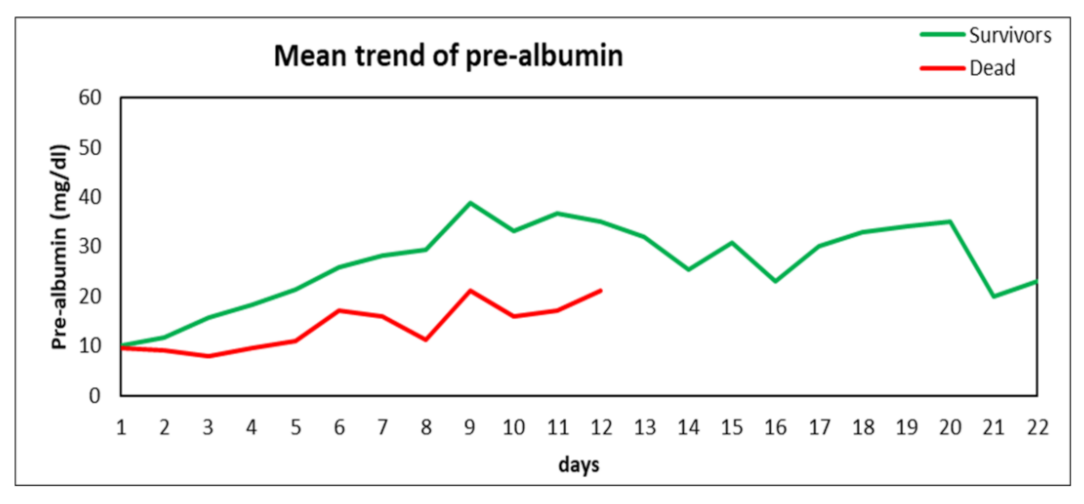
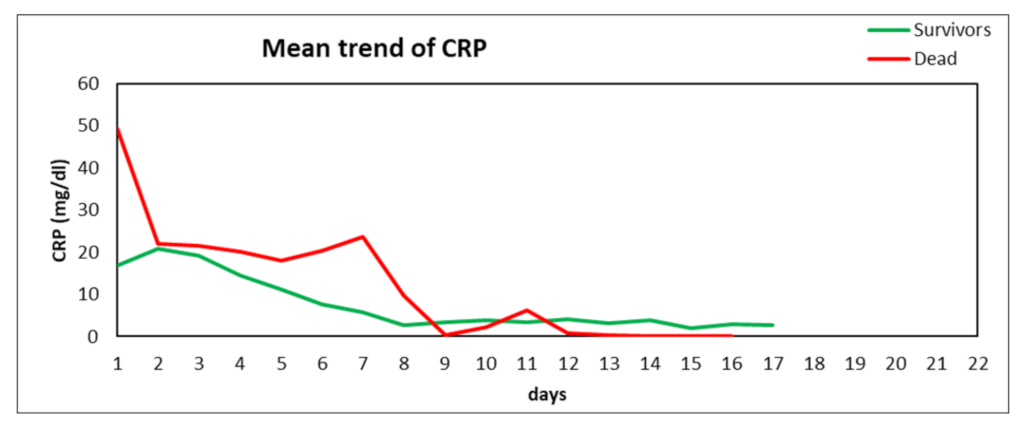
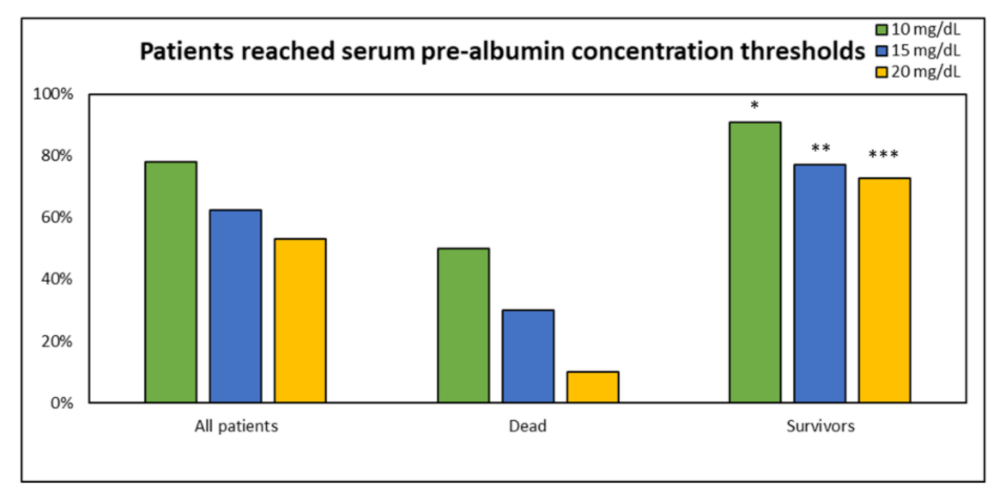
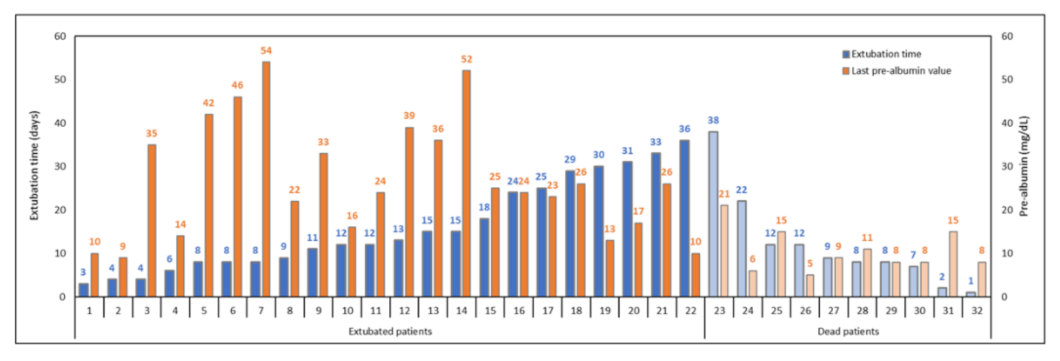

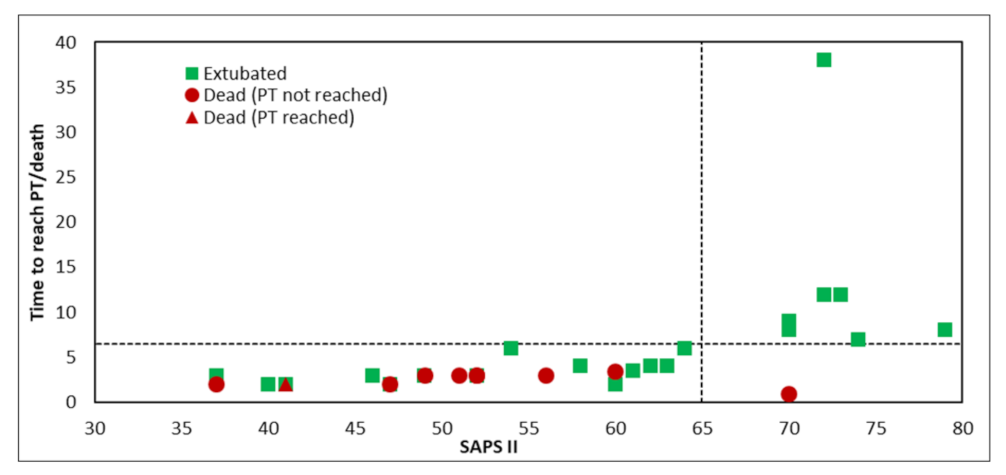
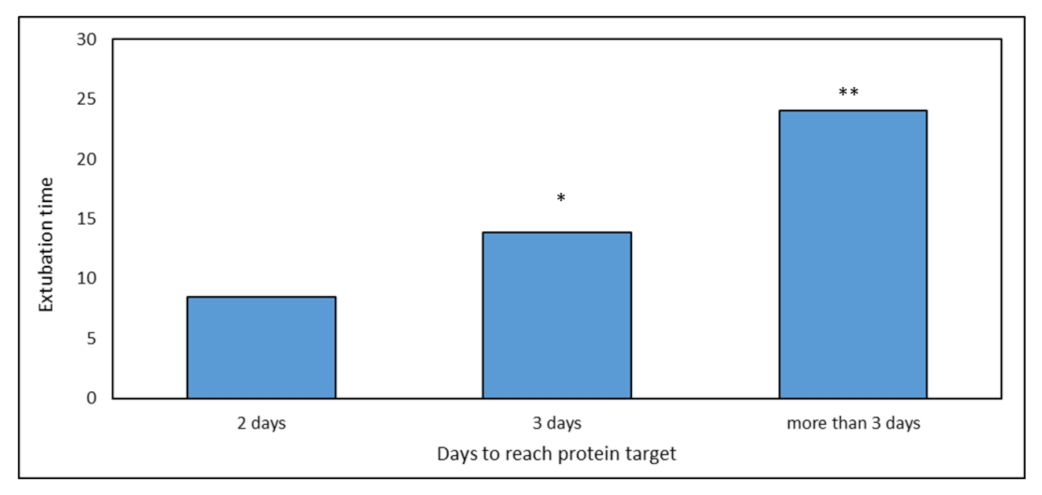
| Patients (n) | Age (years) | SAPS II | IC (mRee, kcal/kg/d) | Mortality | |
|---|---|---|---|---|---|
| All patients | 32 | 68.0 ± 12.5 | 57.3 ± 12.0 | 21.3 ± 1.0 | 31.3% |
| Non survivors | 10 | 77.7 ± 8.7 * | 69.9 ± 7.9 ** | 25.4 ± 1.2 | NA |
| Survivors | 22 | 63.5 ± 11.5 | 51.5 ± 8.8 | 22.1 ± 1.1 | NA |
| p-value | <0.05 | <0.05 | NS | NA |
Publisher’s Note: MDPI stays neutral with regard to jurisdictional claims in published maps and institutional affiliations. |
© 2022 by the authors. Licensee MDPI, Basel, Switzerland. This article is an open access article distributed under the terms and conditions of the Creative Commons Attribution (CC BY) license (https://creativecommons.org/licenses/by/4.0/).
Share and Cite
Scarcella, M.; Scarpellini, E.; Ascani, A.; Commissari, R.; Scorcella, C.; Zanetti, M.; Parisi, A.; Monti, R.; Milic, N.; Donati, A.; et al. Effect of Whey Proteins on Malnutrition and Extubating Time of Critically Ill COVID-19 Patients. Nutrients 2022, 14, 437. https://doi.org/10.3390/nu14030437
Scarcella M, Scarpellini E, Ascani A, Commissari R, Scorcella C, Zanetti M, Parisi A, Monti R, Milic N, Donati A, et al. Effect of Whey Proteins on Malnutrition and Extubating Time of Critically Ill COVID-19 Patients. Nutrients. 2022; 14(3):437. https://doi.org/10.3390/nu14030437
Chicago/Turabian StyleScarcella, Marialaura, Emidio Scarpellini, Alessandra Ascani, Rita Commissari, Claudia Scorcella, Michela Zanetti, Amilcare Parisi, Riccardo Monti, Natasa Milic, Abele Donati, and et al. 2022. "Effect of Whey Proteins on Malnutrition and Extubating Time of Critically Ill COVID-19 Patients" Nutrients 14, no. 3: 437. https://doi.org/10.3390/nu14030437







